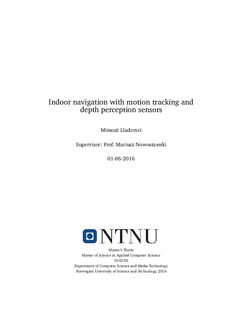| dc.description.abstract | With all the advances in technology, indoor navigation continues to remain an open problem. While we are able to use satellite-based navigation systems such as the Global Positioning System (GPS) and automative navigation systems for navigation outdoors, these systems are not viable for use indoors. Attempts at solving the indoor navigation problem by using approaches such as wireless positioning, RFID tag or beacon placement, among others, have been made, but due to weaknesses of these technologies, their use has not become the standard and widely accepted solution. In this work, we designed an indoor navigation system based on motion tracking and depth perception sensors on board a mobile device, Goolge’s Project Tango. The main advantage of a device with motion tracking and depth perception sensors on board over other candidates for indoor navigation is that it is self-contained, which allows the implementation of an entire indoor navigation system with a single device. Other advantages include low cost and high accuracy in obstacle detection and positioning of the user. The navigation system is designed to guide the user through a collision-free path from start to destination while achieving the shortest path and real-time guidance. Parts of such a system have already been implemented and solutions to some of the problems are presented, but the field lacks a good overview of the indoor navigation workflow and it is not clear how solutions to smaller problems help in solving the bigger problem of indoor navigation. Our work examines the necessary components of the indoor navigation system and breaks down each component to smaller elements, leading in a detailed indoor navigation workflow. Furthermore, we map the solutions that have been provided to some of the challenges that indoor navigation presents to the workflow. Ultimately, we present an obstacle avoidance algorithm that combines global and local motion planning to guide the user around obstacles to the destination. Global path planning alone allows planning of the path from the start to the destination but does not allow room for changes if obstacles are presented along the way. On the other hand, local path planning by itself can deal with path planning in the short term but cannot guarantee that the destination is reached. By combining both approaches so that the global approach is used to plan the total path and the local approach to plan only the parts of the global path that are affected by obstacles, we overcome their weaknesses and achieve a collision-free path to the destination. | nb_NO |
